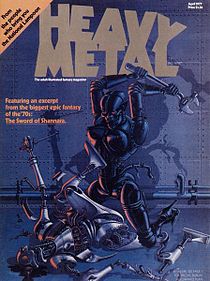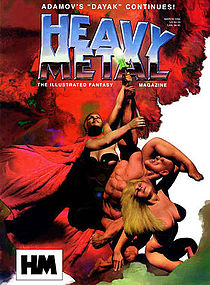- Heavy Metal (magazine)
-
Heavy Metal 
Heavy Metal logo.Managing Editor Debra Yanover Frequency Six times per year Publisher Kevin Eastman First issue 1977 Company Metal Mammoth Inc. Country United States Based in Rockville Centre, New York Website heavymetal.com ISSN 0085-7822 Heavy Metal is an American science fiction and fantasy comics magazine, known primarily for its blend of dark fantasy/science fiction and erotica. In the mid-1970s, while publisher Leonard Mogel was in Paris to jump-start the French edition of National Lampoon, he discovered the French science-fantasy magazine Métal Hurlant which had debuted December 1974. The French title translates literally as "Howling Metal."
When Mogel licensed the American version, he chose to rename it, and Heavy Metal began in the U.S. on April, 1977 as a glossy, full-color monthly. Initially, it displayed translations of graphic stories originally published in Métal Hurlant, including work by Enki Bilal, Jean Giraud (also known as Moebius), Philippe Druillet, Milo Manara and Philippe Caza. The magazine later ran Stefano Tamburini and Tanino Liberatore's ultra-violent RanXerox. Since the color pages had already been shot in France, the budget to reproduce them in the U.S. version was greatly reduced.
Contents
Artists
Heavy Metal's high-quality artwork is notable. Work by international fine artists such as H.R. Giger and Esteban Maroto have been featured on the covers of various issues. Terrance Lindall's illustrated version of Milton's epic poem Paradise Lost appeared in the magazine in 1980.[1] Many stories were presented as long-running serials, such as those by Richard Corben, Pepe Moreno and Matt Howarth. Illustrator Alex Ebel contributed artwork over the course of his career.
The magazine is currently owned and published by Kevin Eastman, co-creator of the Teenage Mutant Ninja Turtles. Publication of the French magazine ceased in 1987. It resumed in July 2002 under the French name Métal Hurlant, edited by Les Humanoïdes Associés.
Editors
The founding editors of the American edition of Heavy Metal were Sean Kelly and Valerie Marchant. Art director and designer John Workman brought to the magazine a background of experience at DC Comics and other publishers.
After two years, Mogel felt the lack of text material was a drawback, and in 1979, he replaced Kelly and Marchant with Ted White, highly regarded in the science fiction field for revitalizing Amazing Stories and Fantastic between 1968 and 1978. White and Workman immediately set about revamping the look of Heavy Metal, incorporating more stories and strips by American artists, including Arthur Suydam, Dan Steffan, Howard Cruse and Bernie Wrightson.
White's main solution to the problem of adding substantive text material was a line-up of columns by four authorities in various aspects of popular culture: Lou Stathis wrote about rock music and Jay Kinney dug into underground comics, while Steve Brown reviewed new science fiction novels and Bhob Stewart explored visual media from fantasy films to animation and light shows.
In 1980, Julie Simmons-Lynch took over as editor, and her new slant on text material was the showcasing of non-fiction by well-known authors such as Robert Silverberg, John Shirley and Harlan Ellison. Later, a review section labeled Dossier, was created by associate editor Brad Balfour, who came on board to handle text features by authors such as William S. Burroughs and Stephen King. Dossier featured short pieces by a variety of writers, and was edited first by Balfour and then by Stathis, who soon replaced Balfour as an editor. Stathis continued the tradition of focusing on pop culture figures to connect the magazine to the larger hip culture context. There were also interviews with such media figures as Roger Corman, Federico Fellini, John Sayles, and John Waters. Beginning with the winter of 1986, Heavy Metal dropped back to a quarterly schedule, continuing until March of 1989, where it then switched over to a bi-monthly publication period. Simmons-Lynch remained the editor until 1991 when Kevin Eastman acquired the magazine and became both publisher and editor.
Films
In 1981, an animated feature film was adapted from several of the magazine's serials. Made on a budget of USD$9,300,000, under production for three years, Heavy Metal featured animated segments from several different animation houses with each doing a single story segment. Another house animated the frame story which tied all the disparate stories together. Like the magazine, the movie featured a great deal of nudity and graphic violence, though not to the degree seen in the magazine. For example, in its Den segment, it did not display the blatant male genitalia of its print counterpart. The film featured such SCTV talents as John Candy, Eugene Levy, Harold Ramis and Ivan Reitman. It did reasonably well in its theatrical release and later gained something of a cult status, partially because a problem with music rights resulted in a delay of many years before the film became available on video. The film was spoofed on an episode of South Park entitled Major Boobage.
Another animated feature film alternatively called Heavy Metal 2000 and Heavy Metal: F.A.K.K.², with a budget of $15,000,000, was released in 2000. This direct-to-video release was not based on stories from the magazine, but instead was based on The Melting Pot, a graphic novel written by Kevin Eastman and drawn by artist Simon Bisley, who based the appearance of the female protagonist after nude model and B-movie actress Julie Strain, ex-wife of Kevin Eastman. Strain later lent her vocal talents to the movie, portraying the character modelled after her likeness. It spawned a video game in 2000, Heavy Metal: F.A.K.K.². An independent video game was also spawned in 2001, Heavy Metal: Geomatrix.
In March 2008, reports circulated that David Fincher and James Cameron would co-direct a new animated Heavy Metal feature before Paramount decided to stop funding it by August 2009.[2] The upcoming Heavy Metal film titled War of the Worlds: Goliath will be released in 2012.
References
- ^ Williamsburg Art & Historical Center with Lindall's illustrations for Paradise Lost
- ^ "Heavy Metal comic to become a film" from ABC.net
External links
Categories:- 1977 comic debuts
- Heavy Metal (magazine)
- Magazines about comics
- Comics anthologies
Wikimedia Foundation. 2010.


